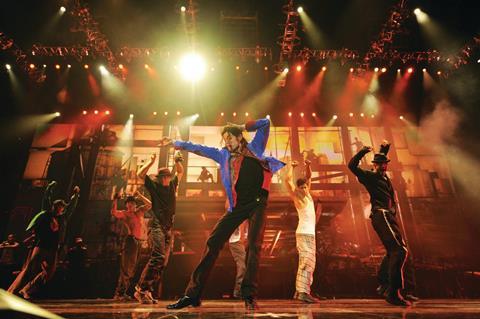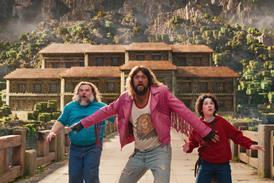As exhibitors and studios alike strive to make the theatrical experience one worth leaving the house for, the long-struggling Imax Corp is finally finding its groove and is set to go into the black for the first time. Jeremy Kay spoke to CEO

Rich Gelfond is, one suspects, too smart to ever allow himself to become self-satisfied. Years of hard grind building up the Imax business have taught him not to count his chickens, but he sounds as if he is smiling down the phone from New York when he says: “We have had our best year ever and that’s only through August.”
In the 15 years since the Imax Corp CEO and Bradley Wechsler acquired the company, they have taken big strides towards transforming their investment.
Back in 1994, Imax was known primarily as a novelty at museums and the occasional tourist attraction, where visitors would strain their necks and gawp at nature documentaries on those famously tall screens.
The screens have retained their height in certain venues, but nowadays they also come in slightly smaller (albeit larger than conventional) formats in multiplexes across North America and other parts of the globe. Nowadays, the company is regarded as an expanding global network in which patrons can enjoy the latest Hollywood releases in digital and 3D.
Increasingly, audiences are seeing Imax less as a novelty and more as an essential viewing experience - especially when certain films are in 3D or sequences are shot on an Imax camera, as Christopher Nolan did on The Dark Knight. With hundreds of retrofitted multiplexes around the world alongside the older, bespoke Imax theatres, the rise of the large-screen format is a trend that Hollywood analysts say is finally going to put the company into profit.
Gelfond is an articulate speaker who seldom pauses before answering a question. However, he takes a moment to reflect when asked about the fundamental changes that promise to put the company in the black after years of struggle. “We’ve freed up the business model,” he says. “Imax has, for its 40-year-plus history, been a wonderful consumer proposition, but it’s taken us a long time to get a business model that has been as good as the consumer model, and that’s because there has been a lot of capital cost for the studios and exhibitors.
“In the early days it cost almost $5m to build an Imax theatre, and it would cost $5m-$10m to make a film and cost $30,000 to make a print. However, over the past five to 10 years we’ve engineered down that cost with the ability to fit technology into a theatre. In the last year we have had an over-the-top push in cost reduction, which is driven by digital expansion and our joint-venture business model [with the exhibitors, retrofitting Imax theatres into multiplexes].
“Digital lowered the cost for exhibitors and added programming flexibility, and helped the studios because it lowered print costs from $30,000 down to around $4,000. The cost of retrofitting was about $150,000-$200,000 and we shared the revenues. Studios were already paying for the movie and we paid for the conversion, and for the exhibitors it didn’t cost too much to retrofit their theatres. That freed up the business model.
“Our network has grown at a rapid pace and in the last year we’ve opened about 100 theatres, two or three a week. We’ve expanded our global footprint and opened our first theatres in Japan, Australia and expanded more rapidly in places like the UK. From the studio point of view, the lower cost of prints means they have been approaching us to release their films.”
Bigger profile
Indeed, the Imax name has been an increasingly common sight in recent years, none more so than 2009. Cloudy With A Chance Of Meatballs is currently playing in 127 domestic and 11 international Imax theatres. The company enjoyed success earlier in the year with Monsters Vs Aliens and Night At The Museum: Battle Of The Smithsonian. It reported a record domestic launch at the start of summer with Star Trek, before going on to gross $40m worldwide with Transformers: Revenge Of The Fallen from 169 domestic and 61 international Imax theatres.
There was the record international launch with Harry Potter And The Half-Blood Prince, Imax’s 19th collaboration with Warner Bros, which generated $3.6m from 62 theatres during the first five days and set new launch-weekend records in the UK, Russia, Japan, France, Brazil, India and Hong Kong. In Japan, the 109 Cinemas Imax theatre in Kawasaki was the highest-grossing screen in the country, taking $130,000 over five days.
Upcoming releases include the Michael Jackson concert-rehearsal film This Is It with Sony, Where The Wild Things Are with Warner Bros (North America only), A Christmas Carol 3D with Disney, and Avatar with Fox. Coming in 2010 are Alice In Wonderland with Disney, DreamWorks Animation’s How To Train Your Dragon and Shrek Goes Fourth, Warner Bros’ Christopher Nolan thriller Inception and Disney’s Tron: Legacy booked in for December 2010. Imax has booked Sony’s Spider Man 4 for summer 2011 and further collaborations on the final two Harry Potter films, while not announced at time of writing, would appear to be a formality.
Revenues, Gelfond explains, come from four sources. There are royalties and maintenance fees from the existing network of theatres. There is the lease-fee business from new theatres, which largely concerns developing markets such as China, Russia, Latin America and Eastern Europe. Imax takes a cut of ticket sales, too, in exchange for picking up the conversion costs in theatres. Finally, there are the joint-venture revenues that come from the US and other Western economies, where Imax invests in theatres and has a stake in performances. “Revenues in the first quarter of this year were less than 20%, but in the second quarter they were close to 50%.”
Global expansion is very much part of the strategy, as one would expect, and nowhere is this more in evidence than in China. “I started travelling there about 12 years ago, and for the first five years we didn’t do any expansion; we were really learning about the market and building relationships. In the last seven or eight years, we’ve signed up about 50 theatres in China and about another 100 in Hong Kong.
“In June we announced a joint venture with the Huayi Brothers to make three films with them and convert the films into Imax. The first one is Aftershock [Feng Xiaogang’s disaster film is set to open in July 2010] and the idea would be that you not only show Hollywood content but Chinese content.” The beauty of this is it may allow Imax a foothold in the Chinese market through local product, should any of its Hollywood blockbusters not make it into the annual foreign quota of 20 films that Chinese theatres are allowed to screen.
No matter which country the audience is in, Gelfond says, the principle remains the same. “I believe that when people leave the home, they’re seeking something very special that they cannot get in the home. We partly fill that void.” A recent survey of 6,000 film-goers in 11 US Imax theatres would appear to back that up. Approximately 89% of respondents said they routinely expected the Imax experience to be superior to a conventional theatre and to that end were prepared to pay the ticket premium levied by exhibitors, usually around 40%.
Will we ever see Imax on the small screen? For only the second time in the conversation, the Imax CEO pauses. “It’s conceivable. The question for us is, is it in keeping with our brand? We’re not going to do it tomorrow, but in the longer term if there was a way to leverage the brand I think we would.”




















2 Readers' comments